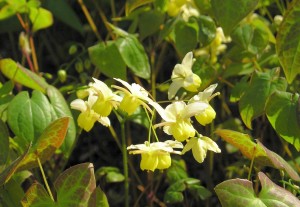 Not long ago a friend called me with dramatic news about epimedium. For those who might be wondering, this is a plant, not a medical condition. Epimedium might occasionally induce euphoria, which is a psychological condition, but that is another story.
Not long ago a friend called me with dramatic news about epimedium. For those who might be wondering, this is a plant, not a medical condition. Epimedium might occasionally induce euphoria, which is a psychological condition, but that is another story.
Epimedium is, in fact, a shade-loving, spring bloomer that covers ground in a very appealing way and easily provides three seasons of interest in exchange for very little labor or input from the gardener. It is also a low-grower, topping out at 12 to 18 inches tall, with a spread of about 12 inches. I have to say that the most vigorous epimedium in my garden, a yellow-flowered beauty, reaches only about 12 inches tall, but has spread to about 18 inches after five years. I am overjoyed by that, because while on its growth rampage, it has prevented weeds from sprouting in its coverage area. This is a trait that is characteristic of the species in general.
Though epimediums are members of the Berberidaceae or barberry family, they look nothing like the typical, spiny barberry shrubs with which we are all familiar. All epimediums feature elongated, heart-shaped leaves and the small flowers that once reminded someone of bishop’s hats or miters, accounting for one of the plant’s common names, “bishop’s hat”. They are also known, romantically, as “fairy wings”, and less romantically as “horny goatweed”. The flowers might also remind you of tiny columbines, complete with long, spur-shaped petals.
My friend’s excitement came from seeing ‘Cosmic Stars’, a bi-colored darker/lighter purple variety that provides a lot of drama and more flowers than many other epimediums. Another Stars epimedium is the vigorous, dangerous sounding ‘Ninja Stars’, with narrower, spiny-looking leaves and yellow flowers. These and many other exciting epimedium varieties have been collected and/or bred by the prolific Darrell Probst, who has traveled throughout Asia and worked with other epimedium collectors and breeders to bring new and improved varieties to market.
Thanks to Probst and others, the epimedium world has expanded beyond what used to be the most available species, Epimedium grandiflorum, or large-flowered epimedium, which bears flowers in white or shades of purplish pink.
The color range has expanded to orange, like Epimedium x warleyense ‘Ellen Willmott’, and the orange and red ‘Stoplights’. Brilliant yellows are widely available, including Epimedium x versicolor ‘Sulphureum’. Specialty catalogs also offer numerous bi-colored varieties like ‘Cupreum’, introduced way back in 1854, and boasting pink flowers with yellow cups.
Petal shapes and sizes may vary as well. ‘Wudan Star’ a white-flowered variety of Epimedium stellulatum, features petals that are pointed, rather than spurred, giving each bloom a star-like shape. The flowers are also larger than normal.
Epimedium leaves play a starring role before and after the plants bloom in the spring. Many species and varieties emerge reddish in the early spring, turn green as the growing season advances, and finally redden again in the fall. In warmer regions the plants may be evergreen, although this does not happen in my USDA Zone 7 garden. Some varieties are variegated, such as the white-flowered ‘Splish Splash’, which features leaves dappled with red/bronze markings. The leaves of ‘Suphureum’ may be mottled with red as well.
For those of us challenged by dry shade, heavy clay soil, or critters like rabbits or deer, epimedium is the answer to a prayer. Be sure, though, to water young plants regularly until they become established. The foliage is also useful for covering the dying leaves of daffodils, tulips and other spring bulbs that emerge and bloom under deciduous trees. The plants make good edgers in shady areas as well.
Once your epimediums have established themselves and spread to cover the available space, you can also divide them easily by digging up and separating the clumps, making sure that each division has a piece of the rhizome attached. If you are like me and have more shady spots than you know what to do with, division is a great remedy.
It is fitting that I first saw “bishop’s hat” over a decade ago in the Bishop’s Garden on the grounds of the National Cathedral in Washington, D.C. The mature planting covered a number of square feet and blanketed the bare earth completely. I saw no weeds at all, which made me wonder if the plants blocked out the weeds, or if the dedicated cadre of volunteer weeders took care of their removal. Either way, I saw the possibilities for epimedium in my own garden.
If the idea of epimediums opens up possibilities for you, try local garden centers, which may carry a few varieties. For excellent selections, go to Digging Dog Nursery, 31101 Middle Ridge Road, Albion, CA 95410; (707) 937-1130; www.diggingdog.com. Print catalog available. You can also try Plant Delights Nursery, 9241 Sauls Rd, Raleigh, NC 27603; (919)-772-4794; www.plantdelights.com. Print catalog available.
